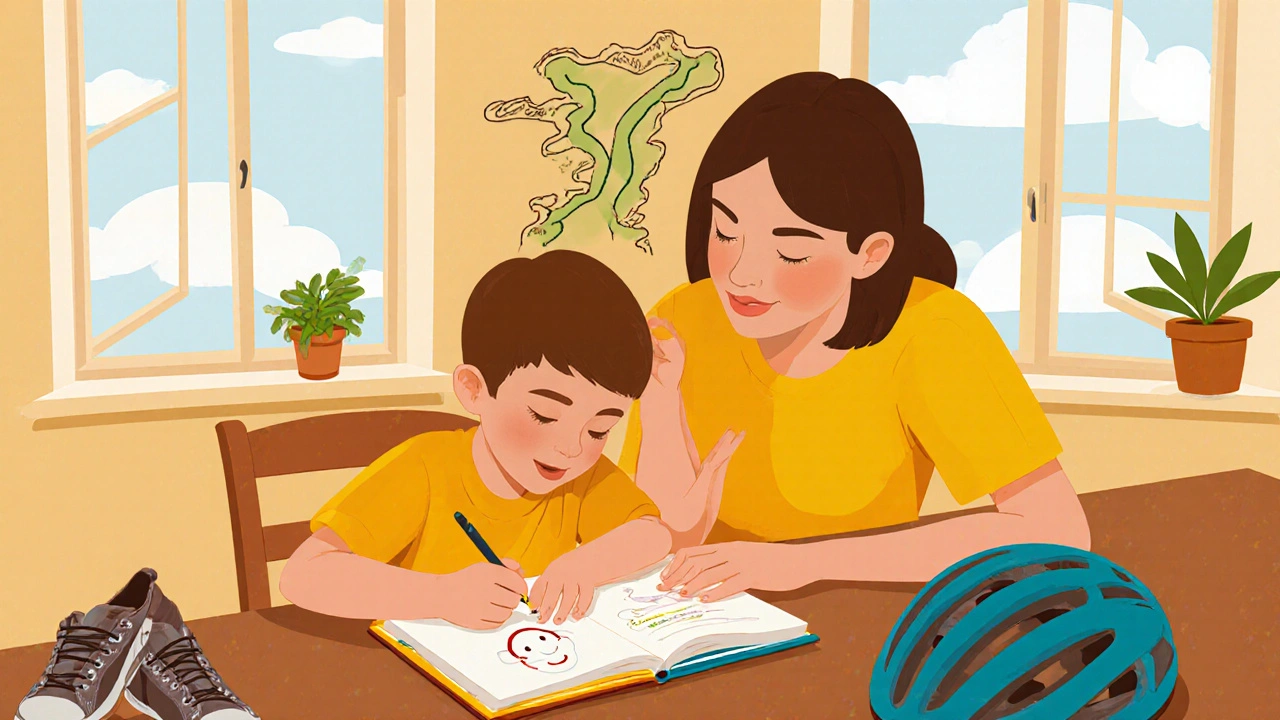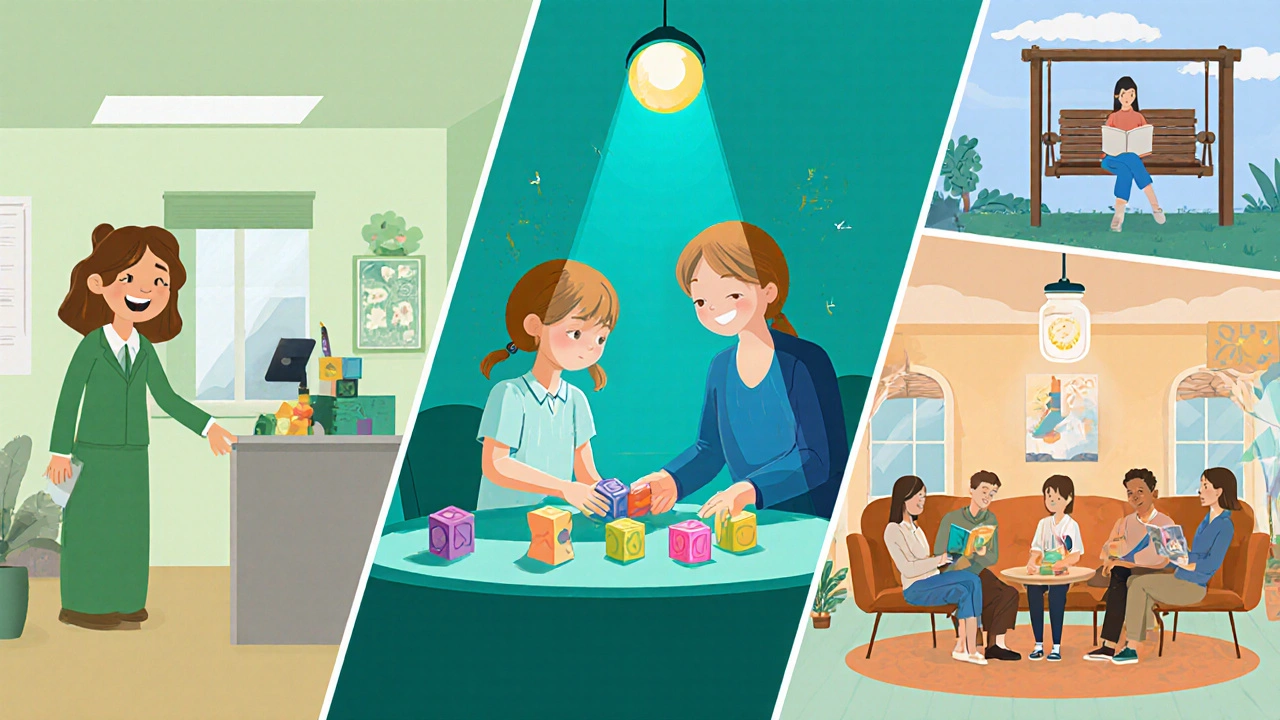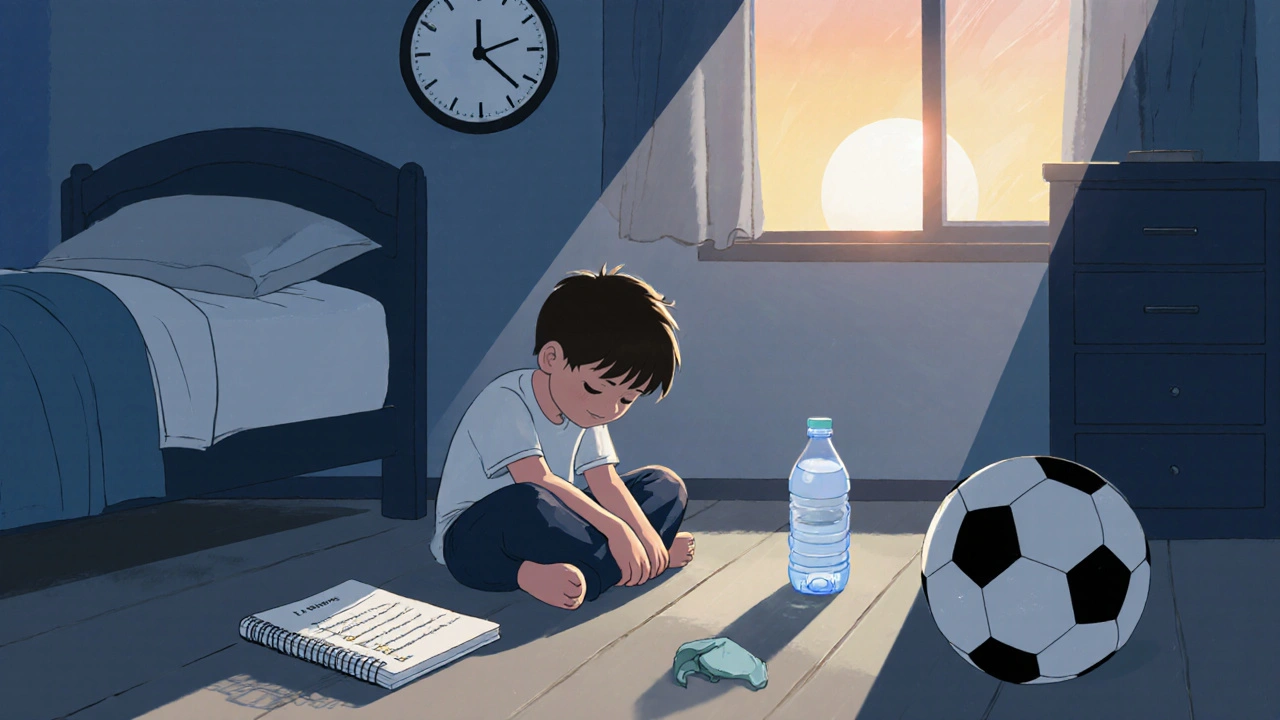When a youngster shows signs of Depressive Disorder a mood condition marked by persistent sadness, loss of interest, and low energy that interferes with daily life, parents often feel scared and unsure. The good news is that with the right steps you can help your child move toward a brighter mood.
Spotting the Warning Lights
Children don’t always put a label on their feelings, so look for changes in behavior rather than waiting for them to say, “I’m sad.” Common clues include:
- Sudden drop in school performance or attendance
- Loss of interest in hobbies they once loved
- Frequent irritability or tearfulness
- Changes in sleep - either insomnia or oversleeping
- Unexplained aches, headaches, or stomach pains
If you notice several of these signs persisting for more than a couple of weeks, it’s time to act.
First‑Response Moves for Parents
Before you schedule appointments, you can create a calm, supportive atmosphere at home:
- Listen without judgment. Ask simple, open‑ended questions like, “How have you been feeling lately?” and then really hear the answer.
- Validate their experience. Even if the feelings seem “over the top,” say, “I hear that you’re hurting, and that matters.”
- Remove immediate stressors when possible - quiet study areas, reduced screen time, or a predictable bedtime routine.
- Encourage physical movement. A short walk or bike ride can boost endorphins without feeling like a “treatment.”
- Start a Mood Diary a simple notebook where the child records daily emotions, triggers, and activities. Seeing patterns can empower both of you.
When Professional Help Is Needed
Most experts agree that a qualified adult should evaluate any child who shows sustained depressive symptoms. Here’s how to begin:
- Contact your pediatrician first. They can rule out medical issues (like thyroid problems) that mimic depression.
- Ask for a referral to a child Psychiatrist a medical doctor specializing in mental‑health diagnosis and medication management for children or a child psychologist.
- Consider a School Counselor a trained professional who can provide short‑term support and coordinate with teachers as an early step.
- Ask about Cognitive Behavioral Therapy (CBT) a structured talk therapy that teaches kids to identify and reframe negative thoughts. Many clinics offer CBT specifically for children.
If medication is recommended, the most common class is Selective Serotonin Reuptake Inhibitor (SSRI) a type of antidepressant that raises serotonin levels in the brain. Fluoxetine and sertraline are FDA‑approved for certain age groups, but dosage and side‑effects must be closely monitored.
Creating a Home That Heals
Kids thrive on routine and safety. Here are concrete ways to turn your house into a recovery zone:
- Set predictable daily rhythms. Regular wake‑up times, meals, and bedtime cues reduce anxiety.
- Limit exposure to negative media. Curate TV shows, video games, and social‑media feeds that promote positivity.
- Introduce “feel‑good” rituals: a gratitude jar, short family stretch sessions, or a weekly “fun night” where the child picks the activity.
- Involve the whole family in Family Therapy sessions where a therapist works with all members to improve communication and resolve conflict if the child’s mood seems tied to home dynamics.
- Join a Parent Support Group a community of caregivers who share experiences, resources, and encouragement. Hearing that you’re not alone can reduce your own stress, which in turn steadies your child.

School and Community Resources
Kids spend a lot of time at school, so enlisting school staff is crucial:
- Schedule a meeting with the School Counselor to discuss accommodations-extra time on tests, a quiet space for breaks, or a peer‑buddy system.
- Ask the teacher for a “check‑in” routine: a brief, private conversation at the start of the day to gauge mood.
- Look for after‑school clubs that foster connection-art, music, or sports-because social belonging is a powerful antidepressant.
- Explore community mental‑health centers that offer sliding‑scale fees for therapy or group sessions.
Medication and Therapy: What to Expect
When a doctor prescribes an SSRI, expect a gradual change. Most kids notice a lift in mood after 2‑4 weeks, but full benefits can take up to 12 weeks. Keep a close eye on:
- Any increase in irritability or agitation (a sign to call the doctor immediately).
- Sleep patterns-both too much and too little can signal dosage issues.
- Appetite changes or new physical symptoms.
Therapy, especially CBT, usually runs 12‑16 weekly sessions. A typical CBT plan includes:
- Identifying “thought traps” (e.g., "I’m a failure").
- Learning to challenge those thoughts with evidence.
- Practicing new coping skills, like deep‑breathing or problem‑solving steps.
Combine medication with therapy whenever possible; research shows the duo works better than either alone for many children.
Ongoing Monitoring and Parent Self‑Care
A child’s journey isn’t linear. Celebrate small wins-maybe they finished a homework assignment without a panic attack. Keep the Mood Diary updated and review it with the therapist each month.
Don’t forget your own mental health. Parenting a child with Depressive Disorder can be draining. Set aside 15 minutes a day for something you enjoy, whether it’s reading, a brisk walk, or a coffee with a friend. A rested parent is better equipped to notice subtle changes in their child.

Quick Checklist for Parents
- Observe and note at least two depressive signs lasting >2 weeks.
- Start a daily Mood Diary with your child.
- Schedule a pediatrician visit and request a mental‑health referral.
- Explore CBT, family therapy, or a school counselor as first‑line non‑medication options.
- If medication is prescribed, monitor side effects and keep follow‑up appointments.
- Join a Parent Support Group for shared experiences.
- Maintain consistent routines at home and encourage physical activity.
- Take care of your own well‑being-rest, nutrition, and stress‑relief.
Comparison of Common Coping Strategies
| Strategy | Key Benefits | Typical Cost | Time Commitment |
|---|---|---|---|
| CBT (Therapist) | Evidence‑based skill building, reduces negative thoughts | $100‑$200 per session (often covered by insurance) | Weekly 45‑minute sessions, 12‑16 weeks |
| Parent‑Led Mood Diary + Routine | Immediate insight, low cost, builds trust | Free (materials only) | 5‑10 minutes daily |
| School Counselor Check‑In | On‑site support, quick referrals, academic accommodations | Usually free through school budget | 10‑15 minutes weekly or as needed |
Frequently Asked Questions
How can I tell the difference between normal teenage mood swings and depressive disorder?
Mood swings happen, but depressive disorder shows persistent sadness, loss of interest, and functional impairment for at least two weeks. If sleep, appetite, or school performance suffer, it’s time to seek help.
Is medication safe for children?
When prescribed by a qualified child psychiatrist and monitored closely, SSRIs are considered safe and effective for many kids. Side‑effects are usually mild and disappear once the dose stabilizes.
Can CBT really help a 10‑year‑old?
Yes. CBT is adapted for younger ages using games, drawings, and age‑appropriate language. It teaches them to spot “thought traps” and replace them with healthier thoughts.
What should I do if my child talks about self‑harm?
Treat it as an emergency. Call a crisis line, go to the nearest emergency department, or contact your child’s psychiatrist right away. Do not leave the child alone.
How often should I follow up with professionals?
Initially, weekly or bi‑weekly appointments are common. Once the child stabilizes, monthly check‑ins usually suffice, but always follow the clinician’s recommendation.
Facing child depression is tough, but with early detection, professional guidance, and a loving home routine, most kids bounce back to a happier, healthier life.


Poornima Ganesan
October 18, 2025 AT 14:38First off, establishing a rock‑solid daily rhythm is non‑negotiable; kids with depression thrive on predictability. Start with a wake‑up time that never shifts, even on weekends, then layer meals, homework, and a short physical activity slot. Keeping the schedule visible on a whiteboard lets the child see progress and reduces anxiety about the unknown.
When stressors pop up, tweak the routine just enough to stay flexible without breaking the whole structure.
Rajesh Singh
October 24, 2025 AT 15:30We have to be clear that shielding a child from every discomfort does them a disservice; resilience is built through gentle exposure, not over‑coddling. Encourage them to face small challenges-like choosing a sport or joining a club-while you stand by as a safety net. This balanced approach teaches accountability and shows that emotions are manageable, not a permanent prison. Remember, moral fortitude grows when we model perseverance, not pity.
Mike Hamilton
October 30, 2025 AT 15:21its also a good idea to have a simple diary where the child can jot down hwo they feel each day its quick and easy.
Matthew Miller
November 5, 2025 AT 16:13Keep the vibes high, get them outside for a quick jog or a bike ride, and celebrate every tiny win like they just conquered the world!
Norman Adams
November 11, 2025 AT 17:05Oh great, another checklist, because that's exactly what depressed kids need.
Margaret pope
November 17, 2025 AT 17:57Totally agree on the schedule thing-having a visible plan really cuts down the guessing game for kids. Also, sprinkle in a “gratitude moment” at dinner where everyone shares one positive thing; it shifts focus without feeling forced. Keep the language light, no heavy lecturing, just gentle nudges. This way the routine feels like a family habit, not a punishment.
Karla Johnson
November 23, 2025 AT 18:48When a parent first notices the subtle signs of a child’s low mood, the instinct to jump straight into professional help is understandable, but there’s value in a measured, multi‑layered approach. Begin by mapping out all the observable changes-sleep patterns, appetite, school performance-on a single sheet, so you have a concrete reference point. Next, involve the child in a brief, daily check‑in where they label their emotions using simple words or even color‑coded stickers; this empowers them to articulate feelings that might otherwise remain hidden.
Simultaneously, evaluate the home environment for any hidden stressors, such as excessive screen time, discordant family dynamics, or a chaotic bedtime routine, and make incremental adjustments.
Introduce a short, enjoyable physical activity after school; research shows that even ten minutes of movement can trigger endorphin release, which lifts mood without feeling like a medical intervention.
Don’t overlook the power of nutrition-offer balanced meals rich in omega‑3 fatty acids and limit sugary snacks that can cause energy spikes and crashes.
While you’re making these changes, schedule a pediatrician appointment to rule out any physiological issues that might mimic depression, like thyroid irregularities.
If the pediatrician suggests a mental‑health referral, ask for both a child psychologist and a psychiatrist to get a comprehensive perspective.
When therapy begins, consider cognitive‑behavioral techniques that are adapted for younger minds, such as thought‑recording games or role‑play scenarios that teach coping strategies in a playful context.
Encourage the child to keep a “wins” journal where they log any achievement, no matter how small, to reinforce a sense of competence.
Family therapy can also be instrumental; it opens lines of communication and helps each member understand how their actions affect the child’s emotional climate.
Don’t forget to involve the school: a brief meeting with the counselor can secure academic accommodations like extra test time or a quiet space for breaks.
Monitor progress weekly, noting any shifts in behavior, sleep, or appetite, and adjust the plan accordingly-flexibility is key.
Above all, maintain your own self‑care; a rested, emotionally balanced parent is better equipped to model healthy coping for their child.
Finally, celebrate each milestone, however minor, because consistent positive reinforcement builds momentum toward lasting recovery. Remember that change takes time, so patience and persistence are your greatest allies.
Linda A
November 29, 2025 AT 19:40One could argue that the very act of ticking boxes reduces the human experience to a spreadsheet, yet within that structure lies the possibility of measurable hope.
Joe Moore
December 5, 2025 AT 20:32Look, the pharma giants have been pushing SSRIs like candy for years, and most parents don’t realize that the “safe” label is just a marketing ploy; you’re basically handing a child a chemical shortcut while the real fix-community, diet, genuine connection-gets ignored.
Ayla Stewart
December 11, 2025 AT 13:38While I understand concerns about medication, the peer‑reviewed research consistently shows that, when carefully monitored, SSRIs can be a valuable part of a broader treatment plan that also includes therapy and lifestyle changes.